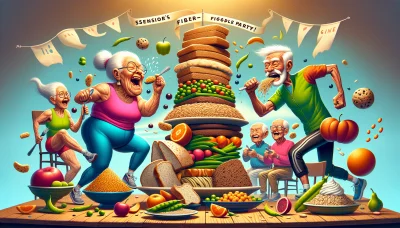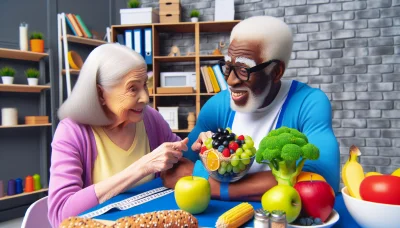Foods high in fiber for weight loss Quiz
Test Your Knowledge
Question of
Understanding Dietary Fiber
What is Dietary Fiber?
Dietary fiber, the indigestible part of plant foods, is a powerhouse for maintaining digestive health. Unlike other food components such as fats, proteins, or carbohydrateswhich your body breaks down and absorbsfiber isn't digested by your body. Instead, it passes relatively intact through your stomach, small intestine, and colon and out of your body.
Fiber is classified into two categories: soluble and insoluble. Soluble fiber dissolves in water to form a gel-like substance which can help lower blood cholesterol and glucose levels. Insoluble fiber, on the other hand, promotes the movement of material through your digestive system and increases stool bulk.
Soluble vs. Insoluble Fiber
Soluble fiber is found in oats, peas, beans, apples, citrus fruits, carrots, barley and psyllium. It attracts water and turns to gel during digestion. Insoluble fiber sources include whole-wheat flour, wheat bran, nuts, beans and vegetables such as cauliflower, green beans and potatoes.
Health Benefits of Fiber
The benefits of dietary fiber are vast. A high-fiber diet has been linked to a lower risk of heart disease and type 2 diabetes. It's also been shown to improve cholesterol levels and bowel healthvital for preventing constipation.
Recommended Daily Intake
The recommended daily intake of dietary fiber varies with age and sex; women typically need about 21 to 25 grams a day while men should aim for 30 to 38 grams a day. Unfortunately, most people are only consuming half this amountindicating a significant gap in the average diet.
The Role of Fiber in Weight Loss
Appetite Suppression
Fiber's ability to absorb water helps make you feel full, which can curb overeating. Foods high in fiber generally require more chewing time as well which gives your body time to register when you're no longer hungry so you're less likely to overeat.
Caloric Impact
Foods high in fiber tend to be less energy dense which means they provide fewer calories per volume of food. This can lead to eating less but feeling more satisfiedperfect for weight management.
Metabolic Enhancement
Some types of soluble fiber are known to act as prebiotics providing food for beneficial gut bacteria which has been linked to improved metabolism and even weight loss.
Sources of Dietary Fiber
Fruits and Vegetables
Fruits and vegetables are rich in dietary fiber especially when consumed with their skins on. Berries such as raspberries and blackberries top the list along with pears apples oranges and carrots.
- *Enumerative Lists: Used for itemizing elements *Descriptive Lists: Each item is accompanied by additional details *Checklists: Designed for tracking completion or presence *Multilevel Lists: Nested lists with items having sub-items *Matrix Lists: Information presented in a grid or table format *Priority Lists: Items organized based on importance or urgency *Comparative Lists: Used for juxtaposing two or more items
Whole Grains
Incorporating whole grains into your diet is another effective way to increase your fiber intake. Look for breads that list whole wheat rye or another whole grain as the first ingredient. Brown rice oatmeal popcorn quinoa are also excellent sources of dietary fiber.
Legumes and Beans
Legumes like lentils chickpeas kidney beans are not only high in protein but also packed with dietary fiber. Incorporating these into meals can significantly boost fiber content making them a staple for anyone looking to improve their intake.
High-Fiber Foods for Weight Management
Fruits Rich in Fiber
Embarking on a weight management journey can be exhilarating when you introduce fiber-rich fruits into your diet! Berries, such as strawberries, raspberries, and blueberries, are not just bursting with flavor but are also brimming with fiber. These tiny nutritional powerhouses can aid in digestion and keep you feeling fuller for longer.
Don't overlook the humble apple or pearespecially with their skin on! These everyday fruits are teeming with fiber and make for an easy, portable snack. And let's not forget the tropical delights like bananas, mangos, and papayas; they're not only a treat to your taste buds but also contribute significantly to your daily fiber intake.
Vegetables with High Fiber Content
Leafy greens are the unsung heroes in the world of high-fiber vegetables. Spinach, kale, and Swiss chard pack a punch not only with fiber but also essential vitamins and minerals. Add them to smoothies or salads for a nutritious boost to your meal.
Cruciferous vegetables like broccoli, Brussels sprouts, and cauliflower are another fantastic source of dietary fiber that support weight management. These veggies can help regulate blood sugar levels and promote a healthy gut. Root vegetables such as carrots, beets, and sweet potatoes also offer a hearty dose of fiber along with a natural sweetness that can satisfy any cravings.
Legumes as a Fiber Powerhouse
Lentils are incredibly versatile and come in various typesred, green, brown, and black. Each variety is packed with fiber and protein which makes them an excellent choice for meatless meals that fill you up without weighing you down.
Beans are another category of legumes that are incredibly high in fiber. Black beans, kidney beans, pinto beansyou name it! They're all great for heart health and can be easily incorporated into soups, stews, or salads. Peas including green peas, split peas, and chickpeas also belong to the legume family and provide substantial amounts of fiber which is crucial for maintaining a healthy digestive system.
- Keep it colorful: Incorporate a variety of fruits and vegetables to ensure a wide range of nutrients.
- Mix it up: Experiment with different ways to prepare legumessuch as in salads, soups or even as hummusto keep meals interesting.
- Stay natural: Opt for whole fruits over juices to get the full benefits of fiber.
- Bulk up: Add lentils or beans to dishes like casseroles or pasta sauces for an easy fiber boost.
- Befriend the freezer: Frozen fruits and vegetables can be just as nutritious as fresh onesand they last longer too!
Integrating Fiber into Your Diet Plan
Breakfast Ideas for a High-Fiber Start
Oatmeal and High-Fiber Cereals
Kick off your morning with a warm bowl of oatmeal, which packs a fiber punch and keeps you full until lunch. Add a sprinkle of flaxseeds or chia seeds for an extra boost. High-fiber cereals are also a fantastic choicejust check the labels to ensure they're low in sugar and high in nutrients.
Smoothies with Fibrous Add-Ins
Blend up a storm with smoothies that include fibrous fruits like berries, pears, or apples. Toss in some greens like spinach or kale for an additional nutrient kick. For an extra fiber boost, add a spoonful of ground flaxseed or wheat germ.
Whole Grain Toast Toppings
Whole grain toast offers more fiber than white bread and serves as an excellent base for various toppings. Try avocado for healthy fats and fiber, or almond butter with banana slices. These toppings not only add fiber but also provide delicious flavors and textures.
- Avoid processed breakfast pastries: They're typically low in fiber and high in sugar.
- Choose whole fruit over juice: You'll get more fiber and less sugar.
- Read cereal labels carefully: Some "high-fiber" cereals are also high in added sugars.
Lunch Options for Sustained Energy
Salads with Fiber-Rich Toppings
Create vibrant salads loaded with fiber by adding chickpeas, kidney beans, or edamame. Top it off with nuts and seeds for crunch and protein. Salads are not only filling but also allow you to mix different sources of fiber in one meal.
Whole Grain Wraps and Sandwiches
Swap out white bread for whole grain wraps or sandwich bread to elevate your lunch's fiber content. Fill them with lean proteins, plenty of vegetables, and hummus or bean spreads to round out the meal.
Hearty Soups with Beans and Lentils
Soups are comforting and can be a great way to sneak more fiber into your diet. Use beans, lentils, and plenty of vegetables to create a fulfilling dish that can be enjoyed any time of the year.
Dinner Recipes for Optimal Fiber Intake
Stir-Fries with an Array of Vegetables
A colorful stir-fry brimming with vegetables like broccoli, bell peppers, and snap peas offers not just flavor but also a significant amount of dietary fiber. Serve over brown rice or quinoa for an even heartier dish that supports your digestive health.
Quinoa and Other Whole Grain Dishes
Incorporate quinoaa complete protein containing all nine essential amino acidsinto your dinner recipes. It's not only rich in protein but also high in fiber. Other whole grains like farro or barley can be tasty alternatives as well.
Hearty Stews with Legumes
A stew made with legumes such as lentils, chickpeas, or black beans is perfect for boosting your fiber intake at dinner time. These ingredients make the meal satisfying while providing ample nutrition to support overall health.
Snacks and Desserts: Fiber without the Guilt
Healthy Snacking on High-Fiber Foods
Transform your snack time with a powerhouse of fiber! Nuts and seeds are not just crunchy delights; they're packed with dietary fiber that can keep you full for hours. A handful of almonds, chia seeds, or flaxseeds can dramatically boost your daily fiber intake.
Dive into the crunch and health combo with vegetable sticks paired with hummus. This perfect duo offers a satisfying crunch along with a creamy, fibrous chickpea spread. It's an unbeatable snack that's both nutritious and delicious!
Say goodbye to greasy chips and hello to air-popped popcorn! This light and fluffy snack is a fantastic source of fiber. It's low in calories, high in volume, and can be seasoned with a sprinkle of nutritional yeast or cinnamon for an extra flavor kick.
Satisfying Your Sweet Tooth with Fiber
Who says desserts can't be healthy? Toss up a colorful fruit salad that's brimming with fiber-rich berries, apples, and oranges. Add a zesty lime dressing for an extra pop of flavor that will make your taste buds dance!
Indulge in the decadent blend of dark chocolate, nuts, and dried fruits. This trio not only satisfies your sweet cravings but also adds a significant amount of fiber to your diet. It's the perfect treat to enjoy without any guilt!
Embrace the goodness of whole grains in your baked goods! Substitute white flour with whole grain flours like oat or almond flour to elevate the fiber content. Your cookies and muffins will not only be healthier but incredibly moist and flavorful.
Beverages That Boost Fiber Intake
Kickstart your day with a green smoothie that packs a punch of fiber. Blend together spinach or kale with your favorite fruits for a nutrient-dense beverage. It's an energizing drink that fuels your body and feeds your gut microbiome.
Stay hydrated and boost your fiber intake simultaneously with fruit-infused waters. Add slices of fiber-rich fruits like berries or kiwi to your water bottle for a refreshing twist on hydration. It's subtle, delicious, and beneficial for digestion.
- Choose high-fiber herbs: When brewing herbal teas, opt for blends that include fibrous herbs like chicory root or dandelion root.
- Avoid adding sugars: Keep it natural by avoiding added sugars which can negate the health benefits of your fibrous drink.
- Pair wisely: Combine these beverages with other high-fiber snacks for maximum benefit.
Understanding the Glycemic Index in High-Fiber Diets
The Importance of Low-Glycemic Foods for Weight Loss
Embracing low-glycemic foods is a game-changer for weight loss! These nutritional powerhouses help maintain steady blood sugar levels, preventing those notorious spikes and crashes. This steadiness is key to curbing sudden hunger pangs and may lead to a more sustainable weight loss journey. Imagine feeling full longer and waving goodbye to those pesky cravings!
But it's not just about shedding pounds; incorporating low-glycemic foods into your diet has profound long-term health benefits. By stabilizing blood sugar, you're also reducing the risk of developing type 2 diabetes and cardiovascular diseases. It's a win-win situation that promotes overall health and well-being.
Combining High Fiber with Low Glycemic Choices
Selecting the right grains and cereals can transform your diet from good to great! Opt for whole grains like quinoa, barley, and rolled oats that are not only high in fiber but also have a low glycemic index. This combination supports digestion, keeps you satiated, and helps control blood sugar levels.
When it comes to fruits and vegetables, choices like berries, apples, carrots, and leafy greens are your best bet for a low glycemic impact. They pack a punch with vitamins, minerals, and fiber while keeping your blood sugar in check. Legumes such as lentils, chickpeas, and black beans also fit perfectly into this profile, offering protein along with their low glycemic benefits.
Preparing Meals with a Low Glycemic Load
Cooking methods matter when it comes to preserving nutrients in low-glycemic foods. Steaming, roasting, or grilling can enhance flavors without adding unnecessary sugars or unhealthy fats. This ensures you get the full health benefits of these foods while enjoying delicious meals.
Portion control is vital in managing glycemic load even healthy foods can cause sugar spikes if consumed in excess. Here's where balance becomes crucial:
- Eat smaller portions: Stick to recommended serving sizes to keep your glycemic load in check.
- Balance your plate: Combine high-fiber carbohydrates with lean proteins and healthy fats to slow digestion and stabilize blood sugar.
- Space out meals: Regular intervals between meals can prevent blood sugar dips and avoid overeating.
- Avoid processed snacks: Choose whole food options as snacks to maintain energy levels throughout the day.
- Stay hydrated: Drinking water can aid in digestion and help manage appetite.
Balancing meals with protein and healthy fats is essential for creating a satisfying meal with a lower glycemic impact. Including sources like fish, chicken breast, avocados, nuts, and seeds can make your meal not only nutritious but also incredibly tasty!
Meal Planning and Preparation for a High-Fiber Diet
Organizing a Weekly High-Fiber Meal Plan
Embarking on a high-fiber diet requires thoughtful planning to ensure you're meeting your nutritional goals. Start by outlining your meals for the week, focusing on fiber-dense foods like fruits, vegetables, whole grains, and legumes. This strategic approach not only keeps you on track but also minimizes food waste and saves time.
When crafting your meal plan, balance is key. Pair high-fiber carbohydrates with lean proteins and healthy fats to create well-rounded meals. Remember to include a variety of colors and textures to ensure you're getting a diverse range of nutrients while keeping meals exciting!
Creating a Shopping List for Fiber-Rich Foods
With your meal plan in hand, compile a shopping list that targets fiber-rich foods. Prioritize whole foods like berries, leafy greens, nuts, seeds, and whole grains. A clear and focused list will streamline your grocery shopping, making it quicker and more efficient.
Don't forget to read labels! Look for products with high dietary fiber content per serving. Be cautious of foods with added sugars or unhealthy fats that can often accompany packaged high-fiber options.
Batch Cooking and Meal Prepping Strategies
Batch cooking is a game-changer for adhering to a high-fiber diet. Prepare large quantities of fiber-rich staples like brown rice, quinoa, or beans at the start of the week. This prep work ensures you have the building blocks ready for quick assembly into various meals.
Investing time in meal prepping can significantly reduce daily kitchen time and help maintain dietary consistency. Use portion-controlled containers to store prepped meals or ingredients, making it easy to grab-and-go throughout the week.
Incorporating Variety to Avoid Dietary Boredom
- Explore different cuisines that naturally emphasize high-fiber ingredients like Indian or Mexican.
- Experiment with new recipes weekly to discover fresh ways to enjoy fiber-rich foods.
- Mix up your cooking methodstry grilling veggies instead of steaming them sometimes.
- Incorporate seasonal produce into your diet for a natural rotation of flavors and nutrients.
Cooking Techniques to Maximize Fiber Retention
Steaming vs. Boiling Vegetables
To preserve the fiber content in vegetables, steaming is superior to boiling. Steaming minimizes nutrient loss by reducing vegetables' contact with water and maintaining structural integrity. This method enhances both nutritional value and texture.
The Benefits of Raw Food Preparation
Incorporating raw foods into your diet is another effective way to maximize fiber intake. Raw fruits and vegetables retain all their natural fibers and enzymes which are often lost during cooking processes. Salads, smoothies, and raw veggie snacks are fantastic options.
Using Slow Cookers for Legume Dishes
Legumes are a fabulous source of fiber; however, they can be time-consuming to prepare traditionally. Utilizing slow cookers simplifies this processsoaking beans overnight then slow-cooking them retains their fibrous benefits while enhancing flavor absorption.
Overcoming Common Challenges in High-Fiber Diets
Managing Increased Digestive Activity
A sudden increase in dietary fiber can lead to digestive discomfortbloating, gas, etc. To mitigate these effects, introduce high-fiber foods gradually into your diet allowing your digestive system time to adjust seamlessly.
Ensuring Adequate Hydration
Fiber absorbs water; thus ample hydration is critical when following a high-fiber diet. Drinking enough fluids supports digestion and helps prevent constipationa common concern when increasing fiber intake.
Adjusting Fiber Intake Gradually
Tracking Progress and Adjusting Your High-Fiber Diet for Weight Loss
Monitoring Your Body's Response to Increased Fiber
Incorporating a high-fiber diet is exhilarating! It's like setting sail on a journey towards better health. But be vigilant, it's essential to monitor your body's reaction as you up the fiber ante. Look out for positive signs such as improved digestion and increased satiety, which signal that your body is adapting well.
However, watch for the red flags of excessive fiber intake, like bloating or discomfort. If these symptoms arise, don't panic! It might simply indicate that your enthusiastic fiber boost needs to be more gradual. Pay attention to these signals theyre the secret dialogue between you and your body!
Adapting your diet to your body's response is crucial. Its all about balance! If you're feeling great with no adverse effects, you might consider increasing fiber even more. But if you're experiencing discomfort, it's a sign to scale back and adjust slowly. Listen to your body; it knows best!
Setting Realistic Goals and Expectations
Goal setting in weight loss is an art! Set realistic short-term milestones that build towards your ultimate dream weight. These stepping stones should be challenging yet achievable think of them as mini victories on your path to success.
Celebrate every victory, scale or non-scale! Whether it's resisting a sugary temptation or noticing a looser fit in your jeans, each triumph deserves recognition. These moments are powerful motivators that fuel your journey forward.
As you progress, its vital to reassess and adjust your goals. If you're surpassing milestones with ease, perhaps its time to aim higher. But if obstacles are frequent, theres no shame in recalibrating for sustainability. The key is continuous progress towards a healthier you!
Seeking Support and Guidance
Youre not alone on this high-fiber adventure! Join communities brimming with individuals who share your passion for high-fiber living. These groups offer encouragement, share experiences, and provide that sense of camaraderie that makes the journey enjoyable.
- Consulting Nutritionists or Dietitians: These experts are treasure troves of knowledge who can tailor a high-fiber plan just for you.
- Utilizing Apps and Tools: Technology can be a steadfast ally in tracking your diet. Use apps to monitor fiber intake and stay on course.
- Mistakes to Avoid:
- Rushing into high fiber without gradual introduction
- Neglecting hydration remember water is fibers best friend!
- Focusing solely on scale victories instead of overall well-being
- Overlooking the importance of variety in a high-fiber diet
In addition to community support, never underestimate the power of professional advice from nutritionists or dietitians. They can provide personalized guidance based on your unique needs and goals. And dont forget about the plethora of apps and tools available today; they're fantastic for keeping track of your dietary intake and ensuring you're getting enough fiber without going overboard.












